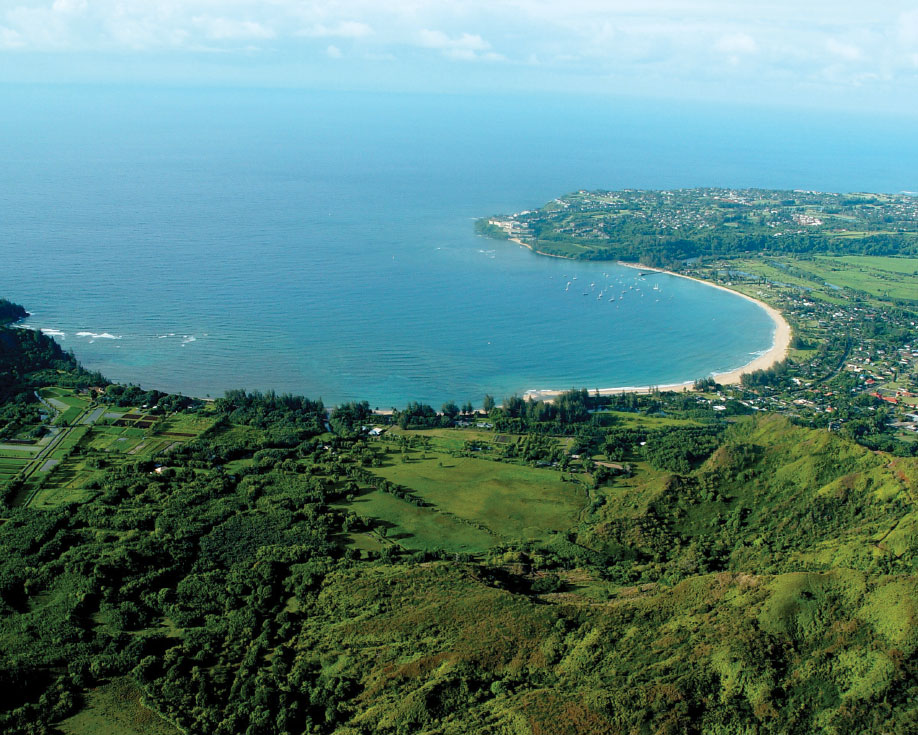Sightseeing The North Shore
By Joan Conrow
Before exploring Kauai’s North Shore, be sure you’ve got lots of time. You’ll want plenty to fully experience the spectacular scenery that characterizes this region.
The dramatic sights start at Anahola, a tiny community framed by big mountains and the even bigger Pacific Ocean. You can get a good photo of the rugged mountain range and its distinctive peaks, Kalalea and Hokualele, from a scenic lookout on the makai (ocean) side of the highway, just past the intersection with Hokualele Road.
The two-lane highway continues on through a rural landscape to the lush pasture lands of the old dairy. The Papaa Mountains form a foreboding backdrop to this pastoral scene. Look for waterfalls after heavy rain. On your right is Moloaa, marked by a roadside fruit stand, small farms and a lovely bay.
As you continue along the highway, the landscape becomes even more lovely and green. You’ll enjoy sweeping views of the North Shore’s massive mountains on your left and the ocean on your right, where you’ll soon catch a glimpse of Crater Hill, an ancient cinder cone. You’re now approaching Kilauea, a former sugar plantation town proud of its rural roots and old stone buildings that hark back to earlier times. You are now en route to the Kilauea Point National Wildlife Refuge. This is one attraction that should not be missed. During the winter, you’ll often see humpback whales spouting and breach- ing in the sea below. For many years, a lighthouse warned ships bound for the Orient of the treacherous waters surrounding the rocky point and Mokuaeae, a small islet offshore. This historic structure, which boasts a rare clamshell lens among the world’s largest, is the focus of a restoration effort that aims to return the tower to its original appearance.
Before the entrance to Kilauea town you’ll pass the entrance to “Common Ground Kauai,” a sustainable resource center that boasts an acre of gardens. The gardens produce most of the food served in the on-site restaurant; two per- maculture garden tours are offered daily.
Not long after passing a small airport, the green expanse of the Prince Course dominates the landscape. It’s open to the public, although part of Princeville Resort. The resort includes the top-rated Makai Course and luxurious Princeville Hotel.
A bit further ahead is the entrance to Princeville, a resort community with stellar views of mountains and sea. It’s the hub of tourism in these parts, with condos, hotels, restaurants, vacation homes, tennis and golf. Across the high- way from the center lies the Hanalei lookout, where you can gaze into Hanalei Valley, with its patchwork of terraces and its mountainous interior. This picturesque scene is arguably one of Hawaii’s most photographed sites.
The road winds down into the valley, crossing Hanalei River on a historic one- lane bridge and continuing on to Hanalei, a small town nestled between a waterfall-streaked mountain range and legendary Hanalei Bay with its miles long sandy beach. It’s ideal for surfing, swimming, kayaking, sunbathing, walking,
jogging and boogie boarding, depending on the season.
From Hanalei, the scenery just gets nicer. The narrow road clings to the mountainside as it follows the curving coastline past lush foliage and pretty beaches.
Haena Beach Park, which is more enticing than the “Dry Cave” across the street, is a good place to stop for a swim. Or head east along the beach to Makua, where the snorkeling is excellent and scuba divers can cruise through underwater lava tubes that inspired its nickname, Tunnels.
The road ends, but not the fun, at Kee Beach. It’s a lovely lagoon surrounded by the towering mountains that mark the start of Na Pali Coast, a state wilderness park and one of the world’s scenic treasures. It can be partly accessed on foot via the 11-mile Kalalau trail, which starts right here. Take a short walk up the trail for a pretty view of the coastline, or hike two miles to Hanakapiai, a dreamy tropical valley with a river and sandy beach. Be sure to bring along more water than you think you’ll need as the trail can be very hot.
Although it’s tempting to wait for the sunset, head back in late afternoon, when the scenery takes on a magical shimmer in the ethereal light, turning soft and gold, then fading to pink and violet as the sun slips behind the mountains.
